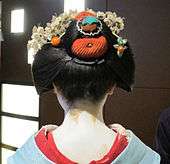Oshiroi
Oshiroi (白粉) is the powder used for foundation, mostly by kabuki actors and geisha, along with their maiko apprentices."白粉" literally means "white powder", while the pronunciation oshiroi means "white" (shiroi) with the honorific prefix o-.
Description
Oshiroi is traditionally applied over a base of special wax called ishineri (石練), applied first to the eyebrows, before bintsuke (facial wax) is applied elsewhere. This application covers the entirety of the face, the neck, and then the back, if the wearer will be dressed in a susohiki (lit., "trailing skirt") type of kimono.
The oshiroi itself is mixed with water before application, and then painted on with a wide, flat brush, over the neck, face and back. It is painted straight over the eyebrows, as the ishineri applied beforehand flattens them to the face, creating a smoother surface that can be painted over. The face is then powdered with rice powder, before the details around the eyes, eyebrows and mouth are drawn in.
The oshiroi must be mixed very carefully with the water to achieve the right consistency; this can prove difficult, especially for those unfamiliar with the process, and requires some practice to get right.
Application

Application of oshiroi varies by occasion, use, and sometimes region (in terms of geisha and maiko).
Both geisha and maiko paint the oshiroi on the back of their neck into a pattern called eri-ashi (襟足) - "neck stripes", describing a two-stripe pattern specifically. For formal occasions, a three stripe pattern is used, called sanbon-ashi (三本足) ('three pointed stripes'). Eri-ashi can be painted freehand with a smaller brush, but sanbon-ashi are painted using a stencil.[1]
Kabuki actors will apply their oshiroi thickly, creating a bright white face visible from the furthest seats in the audience. A kabuki actor doing a quick change between characters may simply paint over their previous makeup, as oshiroi is opaque enough that previous makeup will not be visible.
For geisha and maiko, application of oshiroi varies depending on age, status and region, though it is never applied as thickly as seen in kabuki. Since the application of oshiroi can prove challenging, a younger maiko may have her oka-san ("mother" - the older or retired geisha supervising her training) or her "older sister" geisha mentor apply it for her at first. Senior geisha will begin to wear oshiroi less and less over time, and eventually will only wear it for special occasions and stage performances.
Some regional geisha trainees may blend their oshiroi out to a very light application, whereas others in other regions may wear it more heavily; this depends on the inclinations of the mother of the house and the style of the district.
History
In the past, the type of oshiroi used contained white lead, and would eventually give the wearer lead poisoning.[2] The use of white lead in makeup was outlawed in Japan in 1934.
References
- Ishihara, Tetsuo (2004). Nihongami no Sekai: Maiko no kamigata (The World of Traditional Japanese Hairstyles/Hairstyles of The Maiko) (1st ed.). Kyoto-shi, Japan: The Tetsuo Ishihara Museum of Traditional Japanese Hairstyles. pp. 66–70. ISBN 4990218604.
- Dalby, Liza (2000). Geisha (3rd ed.). London: Vintage Random House. p. 140. ISBN 0 09 928638 6.